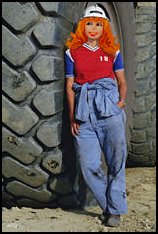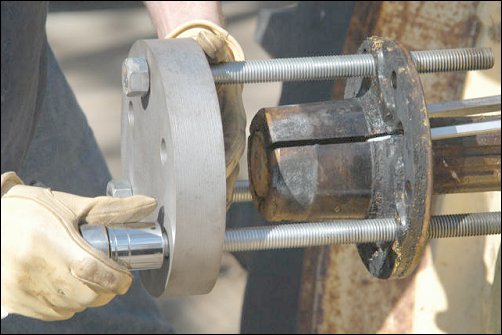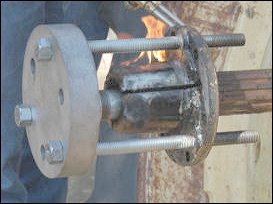How to Pull Off the Rear Wheels
I'm Miss Information
 But, please call me Meli...
But, please call me Meli...The "row-crop" tractors, such as the Model B, have an adjustable rear tread width. If the tractor has been well cared for, you may slide the rear wheels on their axles in the following manner: "All you have to do is loosen all of the hub bolts, then take two of them out completely and put them in the empty holes. These holes are designed as pullers. Just tighten them until the hub breaks loose. The tractor should be jacked up on this side. After the hub breaks loose just tap on the tire to get the wheel to go either out or in. No puller is needed! Tap with a heavy 4 x 6 or something about 10 or 15 lbs." Unfortunately, if you are reading this, it's probably because your tractor has NOT been well cared for and has been abandoned and/or left out in the weather for years and years so that the hubs have rusted SOLID on the axles! In THAT case, moving the wheels requires quite a bit MORE work! I'll show you HOW..... First, squirt the hubs every day with your favorite rust-busting juice. Start doing this the day you buy the tractor! To remove the lock rings from the tapered part of the hub, first take out the three large bolts. Screw two of them into the two unused holes in the ring. This will push the ring off the hub. (I would run a 3/4-10 tap into those holes first, to clean them). If the ring still won't budge, heat it with a torch to expand it a little. But don't beat on it with a hammer, especially when it is hot! The hub will come off the axle just a little bit easier if you get the wheel off of it first, so it can "give" a little bit, where the slots are. On the late B, the wheel is usually bolted to the inside of the hub; but that's okay; just remove it and lean it against the tractor. On the earlier B's it is usually bolted to the outside, so you can get it entirely out of the way. And on the earliest B's, especially the unstyled ones, the hub is part of the wheel; so no help there! Be sure to clean off any part of the axle that is exposed. Scrape off the rust, and file off all the burrs. 
You will need to make a puller to get the hub off. In the above picture, the hub has been pulled all the way to the end of the axle and then moved so you can see everything. My puller is a piece of 1" thick steel big enough to drill three clearance holes in, to match the bolt pattern of the hub. (The steel doesn't have to be round like the one that Hill Roberts made, as long as it is big enough for the three holes). Place the piece of steel against the end of the axle, slide some VERY long bolts through it, and thread them into the three holes in the hub. I made my bolts out of 3/4" threaded rod, with nuts welded on the ends.  The bolts may need to be as much as 18" long, depending on where the wheel is, on the axle. It's a lot of bolt turning, but after all this is only a hobby; this is fun, isn't it? Turn each of the bolts a little bit at a time and hopefully the hub will begin to move. Once you have reached the end of the axle you still have about 3" to go! So you must back off your puller and place some scrap pieces of steel shaft on the end of the axle, as shown here, and then pull some more. (Use pieces of round steel stock a bit smaller than the axle. Do NOT use pieces of pipe, they will SQUISH!!)
The bolts may need to be as much as 18" long, depending on where the wheel is, on the axle. It's a lot of bolt turning, but after all this is only a hobby; this is fun, isn't it? Turn each of the bolts a little bit at a time and hopefully the hub will begin to move. Once you have reached the end of the axle you still have about 3" to go! So you must back off your puller and place some scrap pieces of steel shaft on the end of the axle, as shown here, and then pull some more. (Use pieces of round steel stock a bit smaller than the axle. Do NOT use pieces of pipe, they will SQUISH!!)
Once the hub is off, you can clean and file the axle and the hub, so that they will slide effortlessly. When you put it all back together, paint the insides of everything with that silver graphite stuff. With the weight of the wheel on there again, it will be difficult for one person to move it; but with two people pushing evenly, it will be surprisingly easy! You must tighten the hub-lock ring evenly, and you must tighten it WELL! Oh.... Be careful, be patient, and don't figure on pulling off both of your wheels on the same DAY! |
| |
Go back to the page you just came from......
"Wheels"